coolant level LINCOLN MKZ HYBRID 2013 Owners Manual
[x] Cancel search | Manufacturer: LINCOLN, Model Year: 2013, Model line: MKZ HYBRID, Model: LINCOLN MKZ HYBRID 2013Pages: 475, PDF Size: 3.89 MB
Page 101 of 475
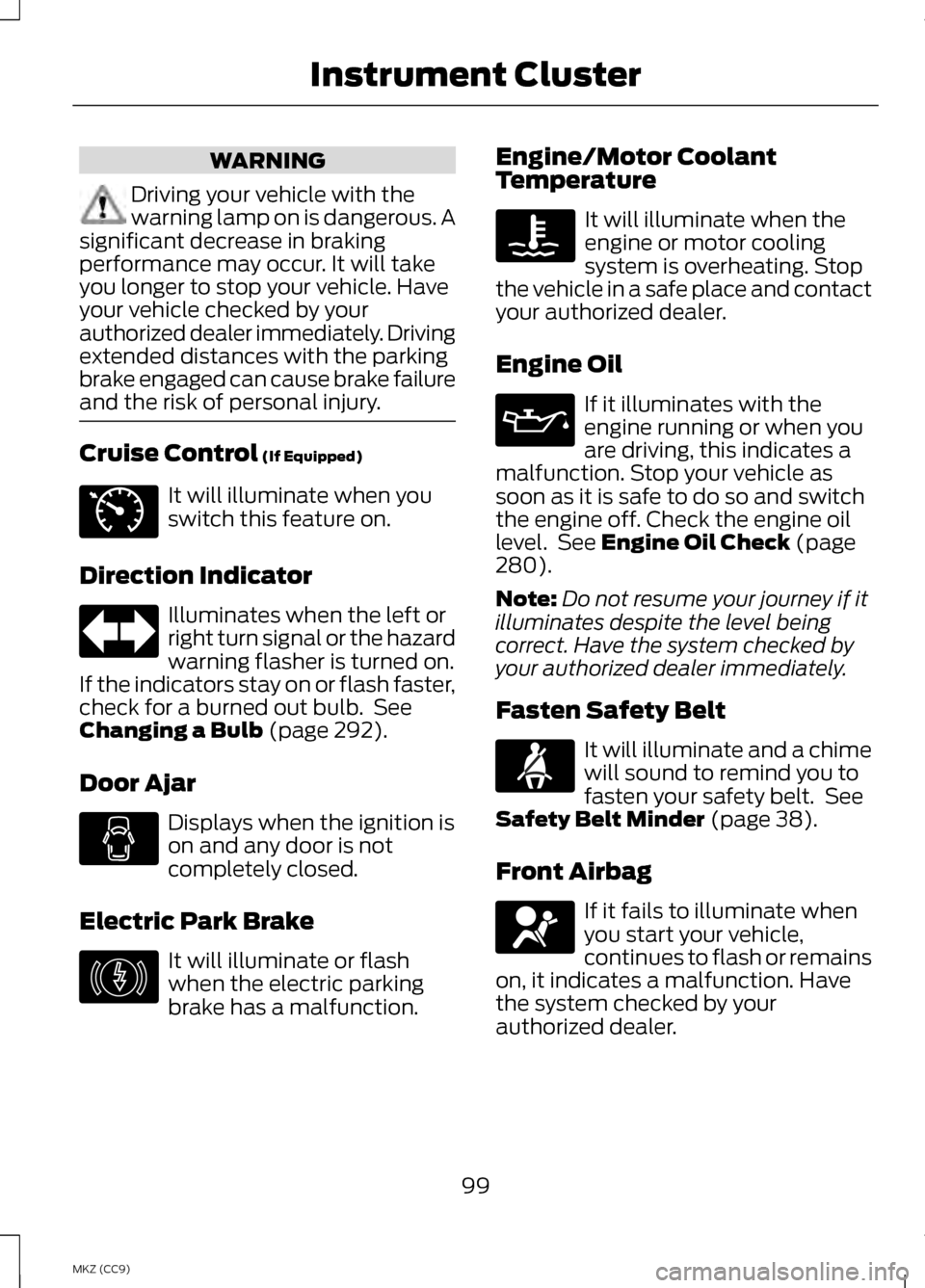
WARNING
Driving your vehicle with the
warning lamp on is dangerous. A
significant decrease in braking
performance may occur. It will take
you longer to stop your vehicle. Have
your vehicle checked by your
authorized dealer immediately. Driving
extended distances with the parking
brake engaged can cause brake failure
and the risk of personal injury. Cruise Control (If Equipped)
It will illuminate when you
switch this feature on.
Direction Indicator Illuminates when the left or
right turn signal or the hazard
warning flasher is turned on.
If the indicators stay on or flash faster,
check for a burned out bulb. See
Changing a Bulb
(page 292).
Door Ajar Displays when the ignition is
on and any door is not
completely closed.
Electric Park Brake It will illuminate or flash
when the electric parking
brake has a malfunction. Engine/Motor Coolant
Temperature It will illuminate when the
engine or motor cooling
system is overheating. Stop
the vehicle in a safe place and contact
your authorized dealer.
Engine Oil If it illuminates with the
engine running or when you
are driving, this indicates a
malfunction. Stop your vehicle as
soon as it is safe to do so and switch
the engine off. Check the engine oil
level. See
Engine Oil Check (page
280).
Note: Do not resume your journey if it
illuminates despite the level being
correct. Have the system checked by
your authorized dealer immediately.
Fasten Safety Belt It will illuminate and a chime
will sound to remind you to
fasten your safety belt. See
Safety Belt Minder
(page 38).
Front Airbag If it fails to illuminate when
you start your vehicle,
continues to flash or remains
on, it indicates a malfunction. Have
the system checked by your
authorized dealer.
99
MKZ (CC9) Instrument ClusterE71340 E146190
Page 107 of 475
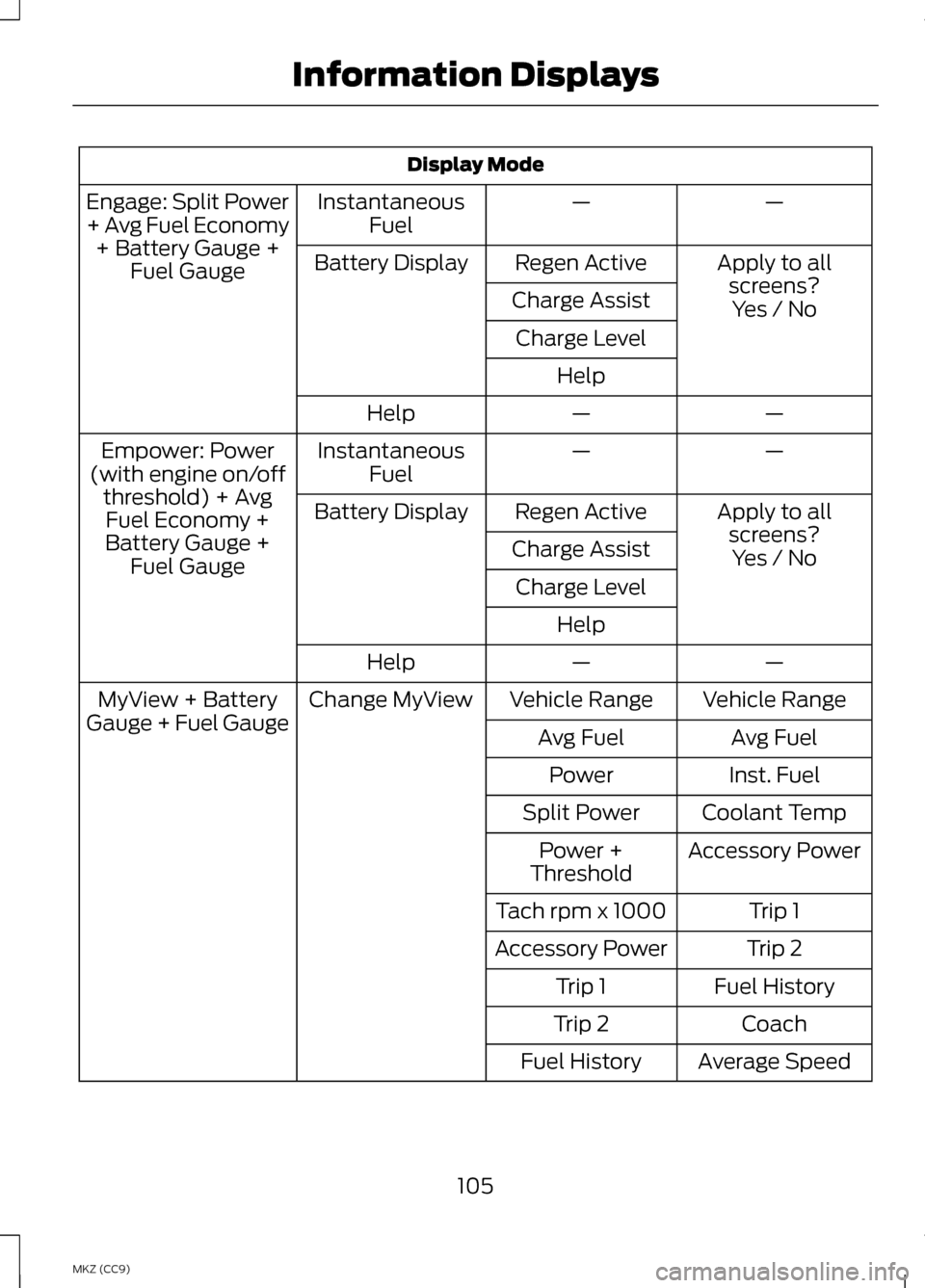
Display Mode
—
—
Instantaneous
Fuel
Engage: Split Power
+ Avg Fuel Economy
+ Battery Gauge + Fuel Gauge Apply to all
screens?
Regen Active
Battery Display
Charge Assist Yes / No
Charge Level
Help —
—
Help
—
—
Instantaneous
Fuel
Empower: Power
(with engine on/off threshold) + AvgFuel Economy +
Battery Gauge + Fuel Gauge Apply to all
screens?Yes / No
Regen Active
Battery Display
Charge AssistCharge Level Help —
—
Help
Vehicle Range
Vehicle Range
Change MyView
MyView + Battery
Gauge + Fuel Gauge Avg Fuel
Avg Fuel
Inst. Fuel
Power
Coolant Temp
Split Power
Accessory Power
Power +
Threshold
Trip 1
Tach rpm x 1000
Trip 2
Accessory Power
Fuel History
Trip 1
Coach
Trip 2
Average Speed
Fuel History
105
MKZ (CC9) Information Displays
Page 111 of 475
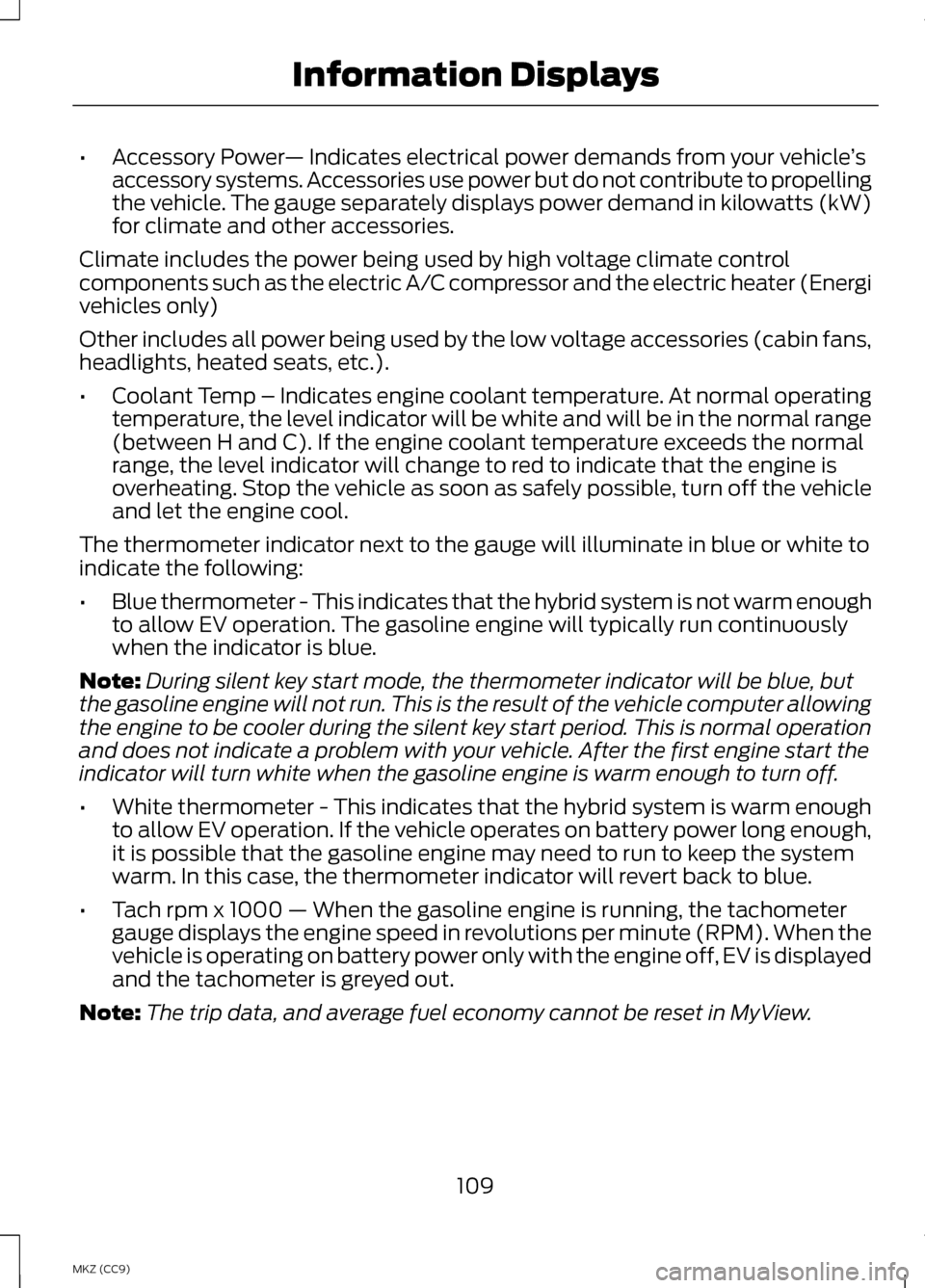
•
Accessory Power — Indicates electrical power demands from your vehicle ’s
accessory systems. Accessories use power but do not contribute to propelling
the vehicle. The gauge separately displays power demand in kilowatts (kW)
for climate and other accessories.
Climate includes the power being used by high voltage climate control
components such as the electric A/C compressor and the electric heater (Energi
vehicles only)
Other includes all power being used by the low voltage accessories (cabin fans,
headlights, heated seats, etc.).
• Coolant Temp – Indicates engine coolant temperature. At normal operating
temperature, the level indicator will be white and will be in the normal range
(between H and C). If the engine coolant temperature exceeds the normal
range, the level indicator will change to red to indicate that the engine is
overheating. Stop the vehicle as soon as safely possible, turn off the vehicle
and let the engine cool.
The thermometer indicator next to the gauge will illuminate in blue or white to
indicate the following:
• Blue thermometer - This indicates that the hybrid system is not warm enough
to allow EV operation. The gasoline engine will typically run continuously
when the indicator is blue.
Note: During silent key start mode, the thermometer indicator will be blue, but
the gasoline engine will not run. This is the result of the vehicle computer allowing
the engine to be cooler during the silent key start period. This is normal operation
and does not indicate a problem with your vehicle. After the first engine start the
indicator will turn white when the gasoline engine is warm enough to turn off.
• White thermometer - This indicates that the hybrid system is warm enough
to allow EV operation. If the vehicle operates on battery power long enough,
it is possible that the gasoline engine may need to run to keep the system
warm. In this case, the thermometer indicator will revert back to blue.
• Tach rpm x 1000 — When the gasoline engine is running, the tachometer
gauge displays the engine speed in revolutions per minute (RPM). When the
vehicle is operating on battery power only with the engine off, EV is displayed
and the tachometer is greyed out.
Note: The trip data, and average fuel economy cannot be reset in MyView.
109
MKZ (CC9) Information Displays
Page 127 of 475
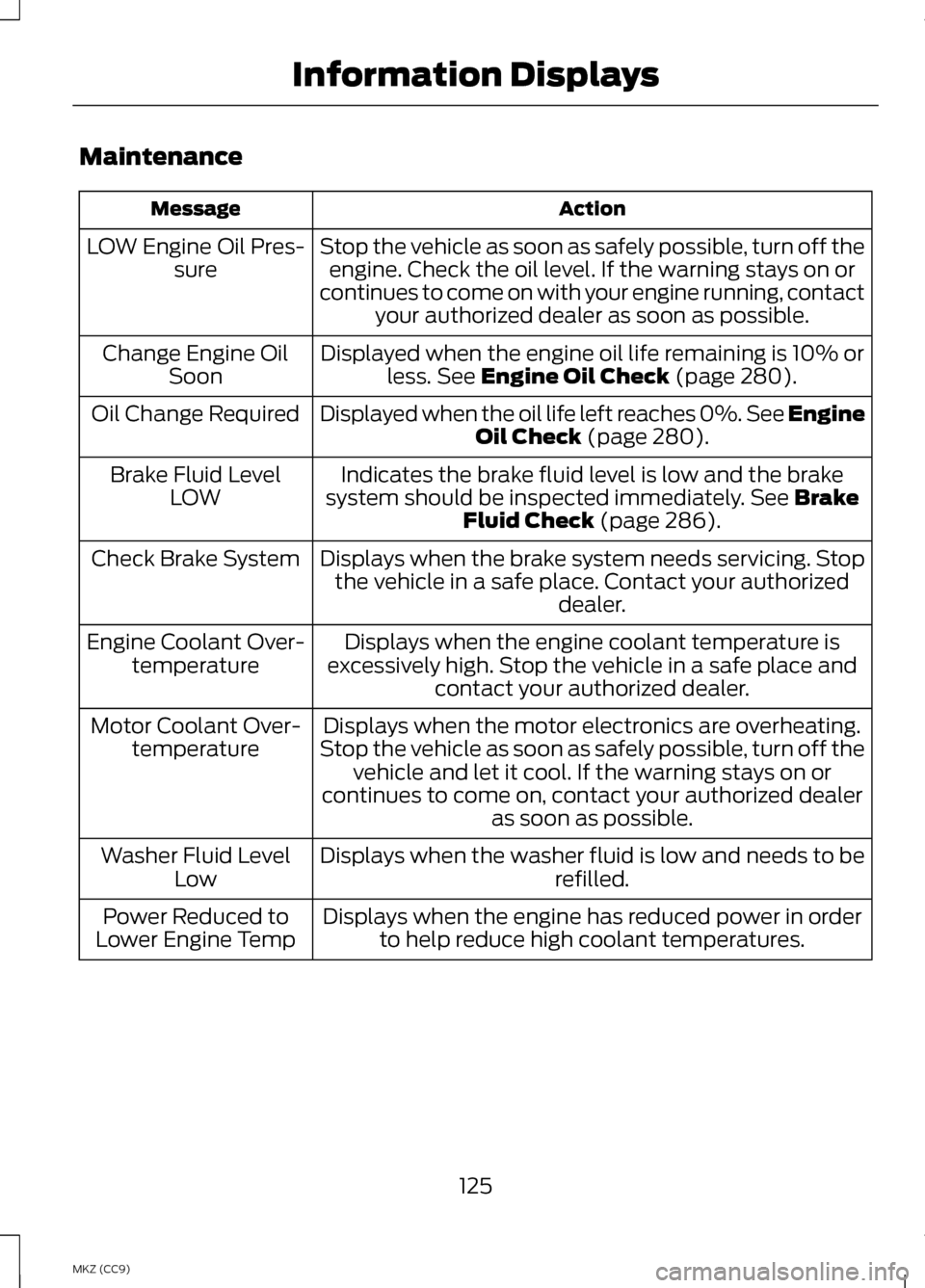
Maintenance
Action
Message
Stop the vehicle as soon as safely possible, turn off theengine. Check the oil level. If the warning stays on or
continues to come on with your engine running, contact your authorized dealer as soon as possible.
LOW Engine Oil Pres-
sure
Displayed when the engine oil life remaining is 10% orless. See Engine Oil Check (page 280).
Change Engine Oil
Soon
Displayed when the oil life left reaches 0%. See Engine Oil Check
(page 280).
Oil Change Required
Indicates the brake fluid level is low and the brake
system should be inspected immediately.
See Brake
Fluid Check (page 286).
Brake Fluid Level
LOW
Displays when the brake system needs servicing. Stopthe vehicle in a safe place. Contact your authorized dealer.
Check Brake System
Displays when the engine coolant temperature is
excessively high. Stop the vehicle in a safe place and contact your authorized dealer.
Engine Coolant Over-
temperature
Displays when the motor electronics are overheating.
Stop the vehicle as soon as safely possible, turn off the vehicle and let it cool. If the warning stays on or
continues to come on, contact your authorized dealer as soon as possible.
Motor Coolant Over-
temperature
Displays when the washer fluid is low and needs to be refilled.
Washer Fluid Level
Low
Displays when the engine has reduced power in orderto help reduce high coolant temperatures.
Power Reduced to
Lower Engine Temp
125
MKZ (CC9) Information Displays
Page 172 of 475
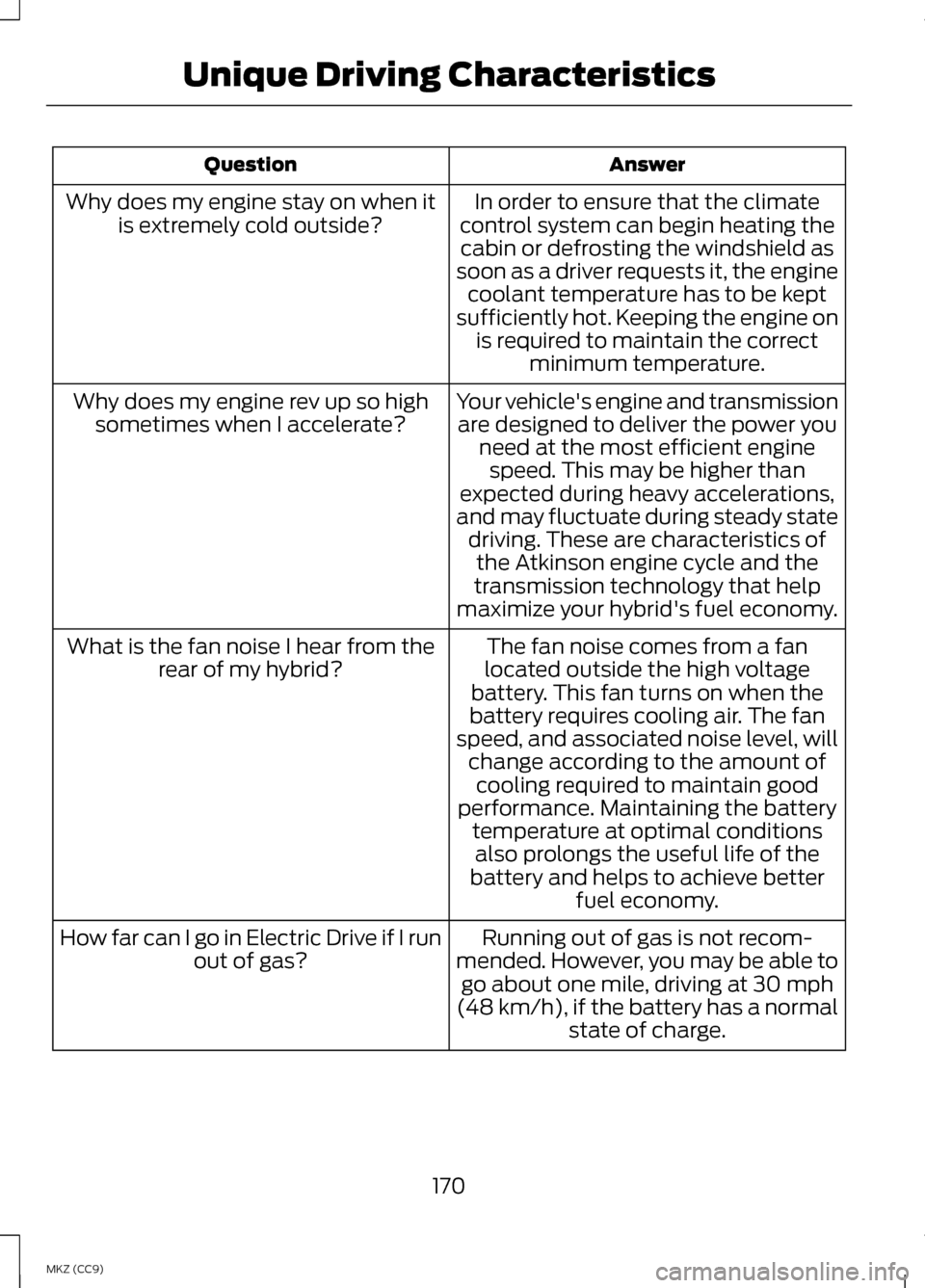
Answer
Question
In order to ensure that the climate
control system can begin heating the cabin or defrosting the windshield as
soon as a driver requests it, the engine coolant temperature has to be kept
sufficiently hot. Keeping the engine on is required to maintain the correct minimum temperature.
Why does my engine stay on when it
is extremely cold outside?
Your vehicle's engine and transmissionare designed to deliver the power you need at the most efficient enginespeed. This may be higher than
expected during heavy accelerations,
and may fluctuate during steady state driving. These are characteristics ofthe Atkinson engine cycle and the
transmission technology that help
maximize your hybrid's fuel economy.
Why does my engine rev up so high
sometimes when I accelerate?
The fan noise comes from a fan
located outside the high voltage
battery. This fan turns on when the
battery requires cooling air. The fan
speed, and associated noise level, will change according to the amount of
What is the fan noise I hear from the
rear of my hybrid?
cooling required to maintain good
performance. Maintaining the battery temperature at optimal conditionsalso prolongs the useful life of the
battery and helps to achieve better fuel economy.
Running out of gas is not recom-
mended. However, you may be able to go about one mile, driving at 30 mph
(48 km/h), if the battery has a normal state of charge.
How far can I go in Electric Drive if I run
out of gas?
170
MKZ (CC9) Unique Driving Characteristics
Page 283 of 475
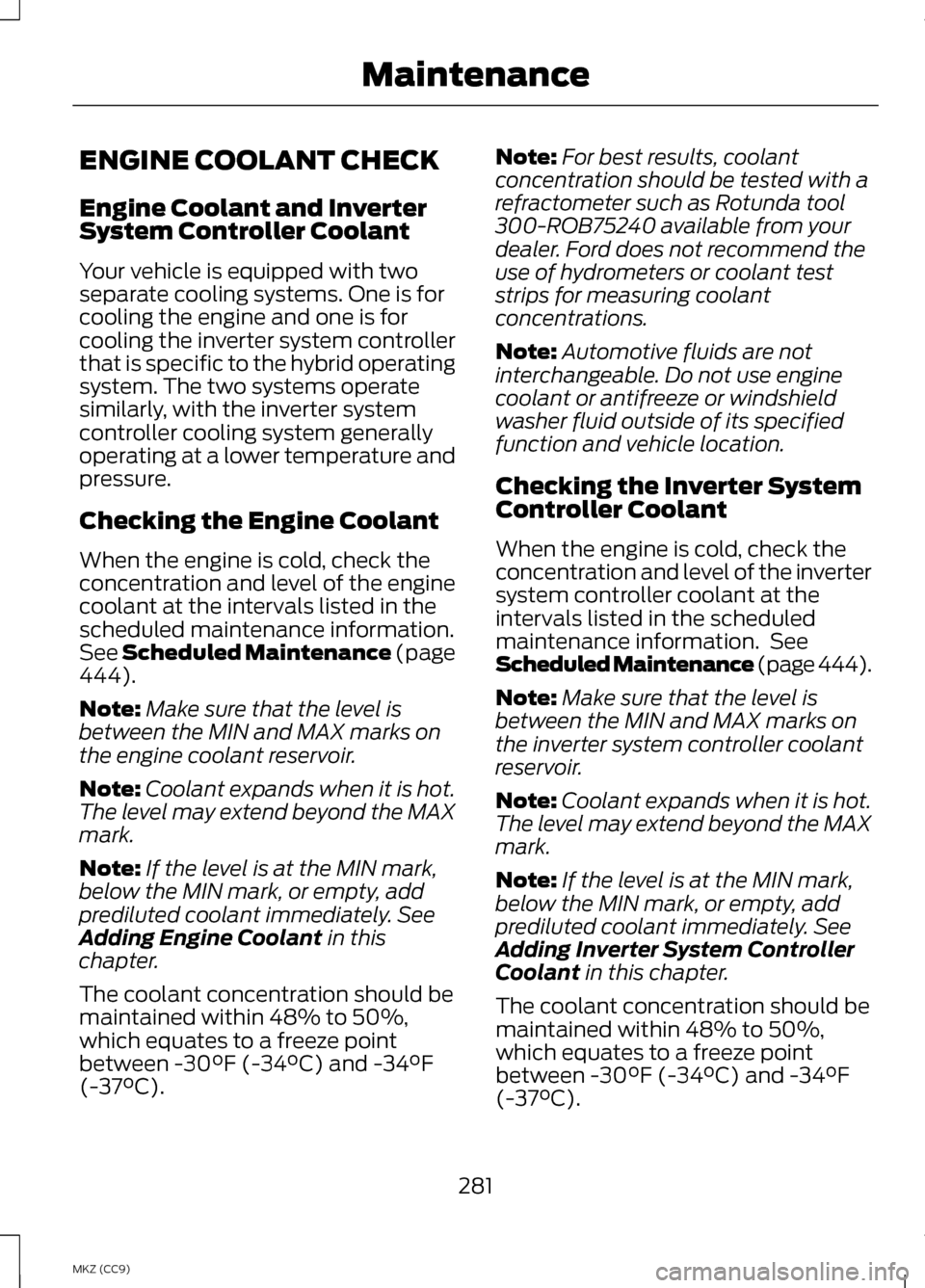
ENGINE COOLANT CHECK
Engine Coolant and Inverter
System Controller Coolant
Your vehicle is equipped with two
separate cooling systems. One is for
cooling the engine and one is for
cooling the inverter system controller
that is specific to the hybrid operating
system. The two systems operate
similarly, with the inverter system
controller cooling system generally
operating at a lower temperature and
pressure.
Checking the Engine Coolant
When the engine is cold, check the
concentration and level of the engine
coolant at the intervals listed in the
scheduled maintenance information.
See Scheduled Maintenance (page
444).
Note: Make sure that the level is
between the MIN and MAX marks on
the engine coolant reservoir.
Note: Coolant expands when it is hot.
The level may extend beyond the MAX
mark.
Note: If the level is at the MIN mark,
below the MIN mark, or empty, add
prediluted coolant immediately. See
Adding Engine Coolant
in this
chapter.
The coolant concentration should be
maintained within 48% to 50%,
which equates to a freeze point
between -30°F (-34°C) and -34°F
(-37°C). Note:
For best results, coolant
concentration should be tested with a
refractometer such as Rotunda tool
300-ROB75240 available from your
dealer. Ford does not recommend the
use of hydrometers or coolant test
strips for measuring coolant
concentrations.
Note: Automotive fluids are not
interchangeable. Do not use engine
coolant or antifreeze or windshield
washer fluid outside of its specified
function and vehicle location.
Checking the Inverter System
Controller Coolant
When the engine is cold, check the
concentration and level of the inverter
system controller coolant at the
intervals listed in the scheduled
maintenance information. See
Scheduled Maintenance (page 444).
Note: Make sure that the level is
between the MIN and MAX marks on
the inverter system controller coolant
reservoir.
Note: Coolant expands when it is hot.
The level may extend beyond the MAX
mark.
Note: If the level is at the MIN mark,
below the MIN mark, or empty, add
prediluted coolant immediately. See
Adding Inverter System Controller
Coolant
in this chapter.
The coolant concentration should be
maintained within 48% to 50%,
which equates to a freeze point
between -30°F (-34°C) and -34°F
(-37°C).
281
MKZ (CC9) Maintenance
Page 285 of 475

•
Do not mix different colors or types
of coolant in your vehicle. Make
sure the correct coolant is used.
Mixing of coolants may harm your
cooling system. The use of an
improper coolant may harm the
engine, inverter system controller,
and cooling system components
and may void the warranty.
• In case of emergency, a large
amount of water without engine
coolant may be added to the
engine cooling system only in order
to reach a vehicle service location.
In this instance, the engine cooling
system must be drained,
chemically cleaned with
Motorcraft Premium Cooling
System Flush, and refilled with
prediluted engine coolant as soon
as possible. Water alone (without
engine coolant) can cause engine
damage from corrosion,
overheating, or freezing. DO NOT
use this method for the inverter
system controller cooling system.
The inverter system controller
cooling system operates close to
ambient temperature, and is
susceptible to freezing in any
subfreezing environment in the
absence of coolant. •
Do not use alcohol, methanol,
brine or any engine coolants mixed
with alcohol or methanol
antifreeze (coolant). Alcohol and
other liquids can cause engine
damage from overheating or
freezing.
• Do not add extra inhibitors or
additives to the coolant. These can
be harmful and compromise the
corrosion protection of the engine
coolant.
Adding Engine Coolant
1. Unscrew the engine coolant reservoir cap slowly. Any pressure
will escape as you unscrew the
cap.
2. Use a funnel to add prediluted engine coolant to the engine
coolant reservoir. Make sure that
the level is between the MIN and
MAX marks on the engine coolant
reservoir. Use prediluted engine
coolant meeting the Ford
specification. See Capacities and
Specifications (page 330).
3. Close the engine coolant reservoir
cap.
Whenever you add coolant, check the
coolant level in the engine coolant
reservoir the next few times you drive
the vehicle. If necessary, add enough
prediluted engine coolant to bring the
engine coolant level to the proper
level.
283
MKZ (CC9) Maintenance
Page 286 of 475
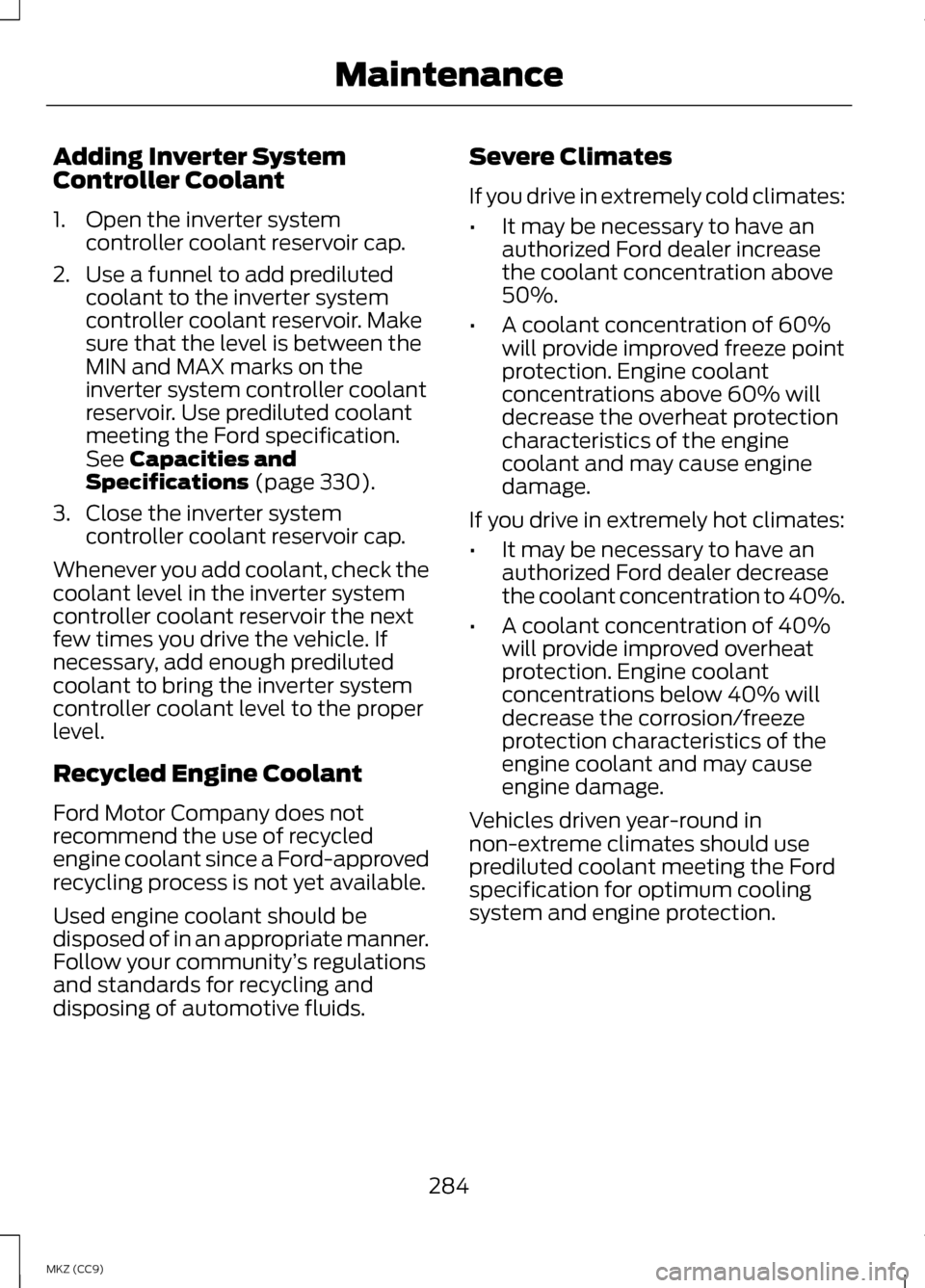
Adding Inverter System
Controller Coolant
1. Open the inverter system
controller coolant reservoir cap.
2. Use a funnel to add prediluted coolant to the inverter system
controller coolant reservoir. Make
sure that the level is between the
MIN and MAX marks on the
inverter system controller coolant
reservoir. Use prediluted coolant
meeting the Ford specification.
See Capacities and
Specifications (page 330).
3. Close the inverter system controller coolant reservoir cap.
Whenever you add coolant, check the
coolant level in the inverter system
controller coolant reservoir the next
few times you drive the vehicle. If
necessary, add enough prediluted
coolant to bring the inverter system
controller coolant level to the proper
level.
Recycled Engine Coolant
Ford Motor Company does not
recommend the use of recycled
engine coolant since a Ford-approved
recycling process is not yet available.
Used engine coolant should be
disposed of in an appropriate manner.
Follow your community ’s regulations
and standards for recycling and
disposing of automotive fluids. Severe Climates
If you drive in extremely cold climates:
•
It may be necessary to have an
authorized Ford dealer increase
the coolant concentration above
50%.
• A coolant concentration of 60%
will provide improved freeze point
protection. Engine coolant
concentrations above 60% will
decrease the overheat protection
characteristics of the engine
coolant and may cause engine
damage.
If you drive in extremely hot climates:
• It may be necessary to have an
authorized Ford dealer decrease
the coolant concentration to 40%.
• A coolant concentration of 40%
will provide improved overheat
protection. Engine coolant
concentrations below 40% will
decrease the corrosion/freeze
protection characteristics of the
engine coolant and may cause
engine damage.
Vehicles driven year-round in
non-extreme climates should use
prediluted coolant meeting the Ford
specification for optimum cooling
system and engine protection.
284
MKZ (CC9) Maintenance
Page 288 of 475
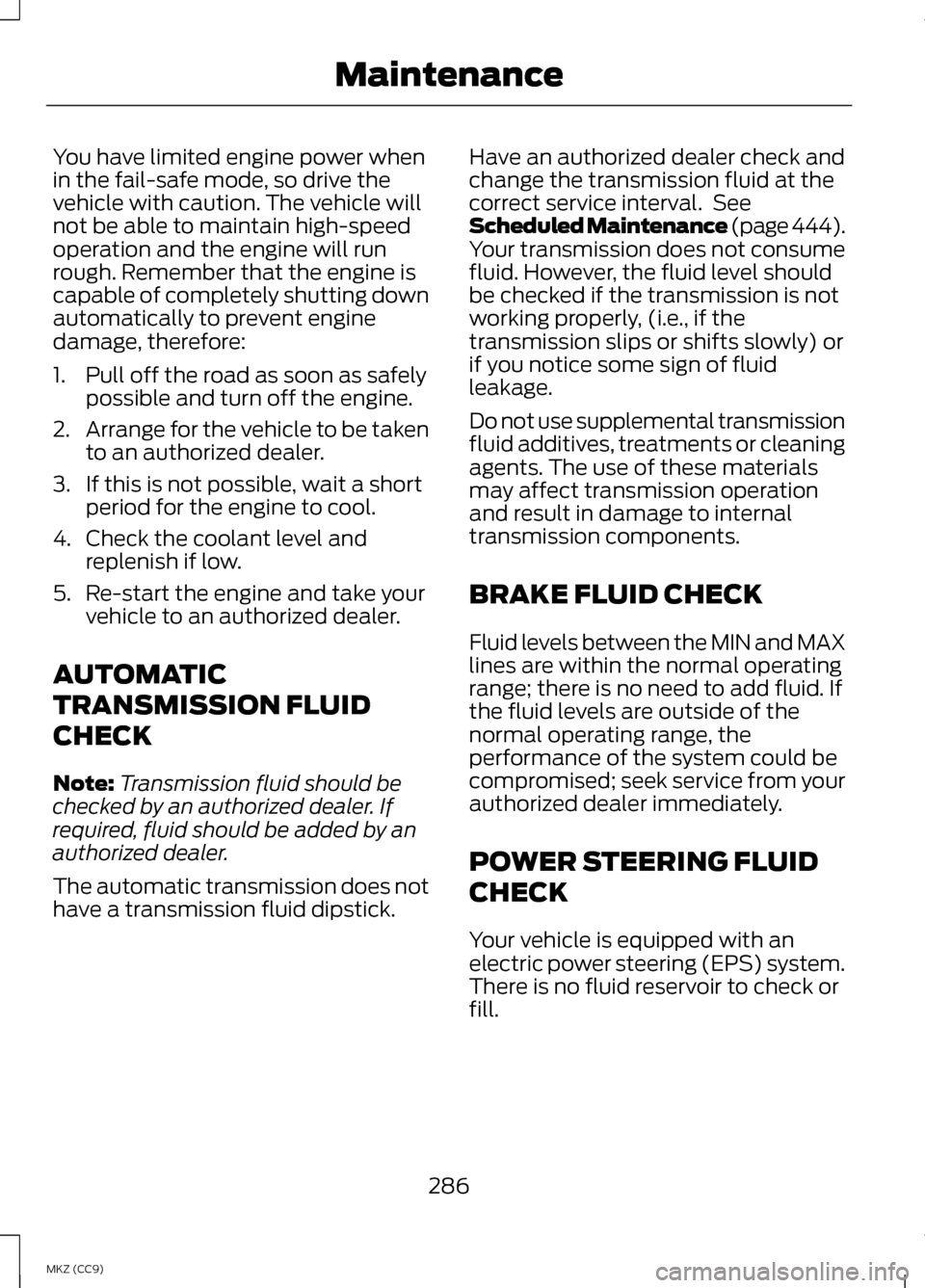
You have limited engine power when
in the fail-safe mode, so drive the
vehicle with caution. The vehicle will
not be able to maintain high-speed
operation and the engine will run
rough. Remember that the engine is
capable of completely shutting down
automatically to prevent engine
damage, therefore:
1. Pull off the road as soon as safely
possible and turn off the engine.
2. Arrange for the vehicle to be taken
to an authorized dealer.
3. If this is not possible, wait a short period for the engine to cool.
4. Check the coolant level and replenish if low.
5. Re-start the engine and take your vehicle to an authorized dealer.
AUTOMATIC
TRANSMISSION FLUID
CHECK
Note: Transmission fluid should be
checked by an authorized dealer. If
required, fluid should be added by an
authorized dealer.
The automatic transmission does not
have a transmission fluid dipstick. Have an authorized dealer check and
change the transmission fluid at the
correct service interval. See
Scheduled Maintenance (page 444).
Your transmission does not consume
fluid. However, the fluid level should
be checked if the transmission is not
working properly, (i.e., if the
transmission slips or shifts slowly) or
if you notice some sign of fluid
leakage.
Do not use supplemental transmission
fluid additives, treatments or cleaning
agents. The use of these materials
may affect transmission operation
and result in damage to internal
transmission components.
BRAKE FLUID CHECK
Fluid levels between the MIN and MAX
lines are within the normal operating
range; there is no need to add fluid. If
the fluid levels are outside of the
normal operating range, the
performance of the system could be
compromised; seek service from your
authorized dealer immediately.
POWER STEERING FLUID
CHECK
Your vehicle is equipped with an
electric power steering (EPS) system.
There is no fluid reservoir to check or
fill.
286
MKZ (CC9) Maintenance
Page 303 of 475
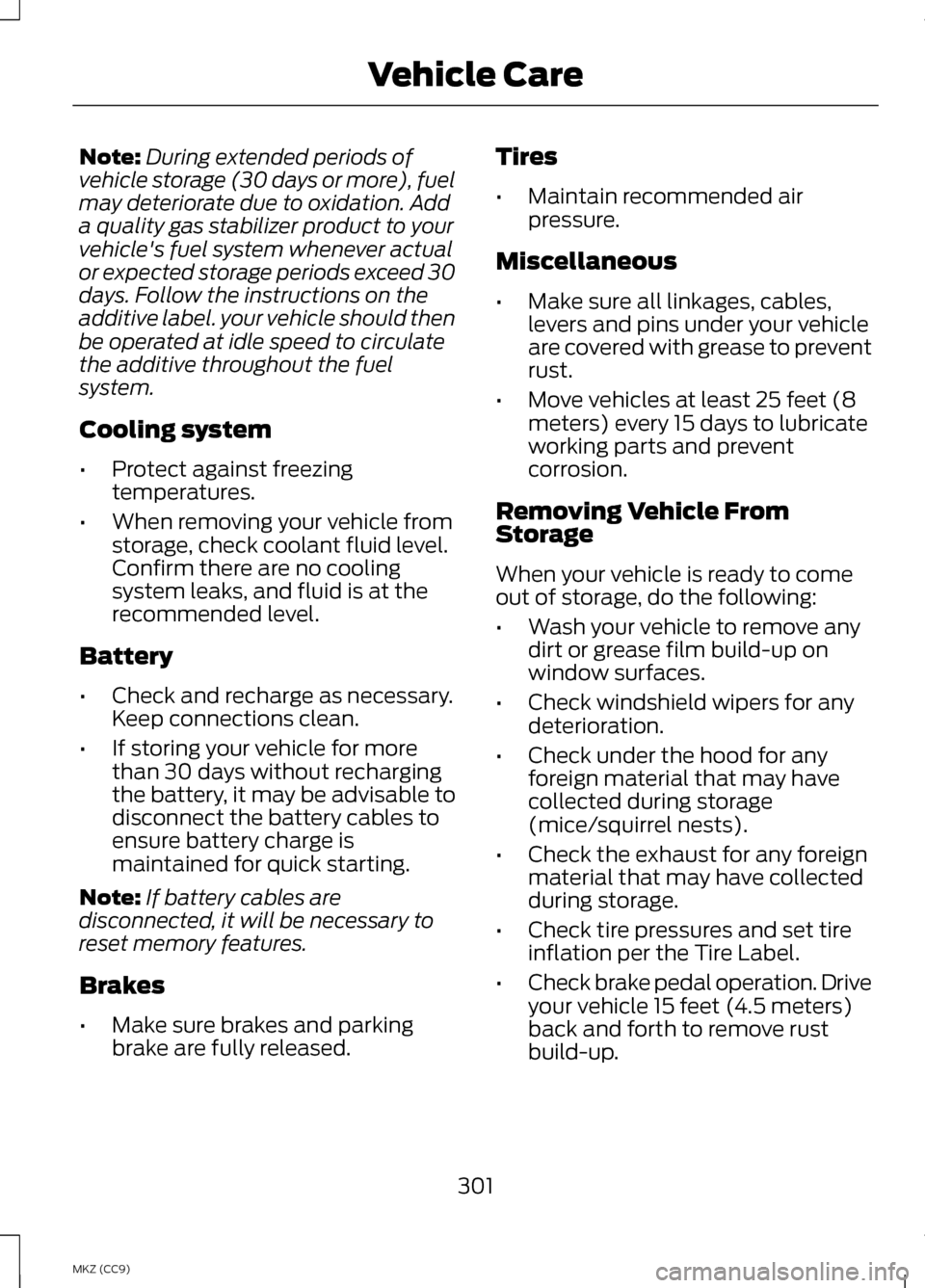
Note:
During extended periods of
vehicle storage (30 days or more), fuel
may deteriorate due to oxidation. Add
a quality gas stabilizer product to your
vehicle's fuel system whenever actual
or expected storage periods exceed 30
days. Follow the instructions on the
additive label. your vehicle should then
be operated at idle speed to circulate
the additive throughout the fuel
system.
Cooling system
• Protect against freezing
temperatures.
• When removing your vehicle from
storage, check coolant fluid level.
Confirm there are no cooling
system leaks, and fluid is at the
recommended level.
Battery
• Check and recharge as necessary.
Keep connections clean.
• If storing your vehicle for more
than 30 days without recharging
the battery, it may be advisable to
disconnect the battery cables to
ensure battery charge is
maintained for quick starting.
Note: If battery cables are
disconnected, it will be necessary to
reset memory features.
Brakes
• Make sure brakes and parking
brake are fully released. Tires
•
Maintain recommended air
pressure.
Miscellaneous
• Make sure all linkages, cables,
levers and pins under your vehicle
are covered with grease to prevent
rust.
• Move vehicles at least 25 feet (8
meters) every 15 days to lubricate
working parts and prevent
corrosion.
Removing Vehicle From
Storage
When your vehicle is ready to come
out of storage, do the following:
• Wash your vehicle to remove any
dirt or grease film build-up on
window surfaces.
• Check windshield wipers for any
deterioration.
• Check under the hood for any
foreign material that may have
collected during storage
(mice/squirrel nests).
• Check the exhaust for any foreign
material that may have collected
during storage.
• Check tire pressures and set tire
inflation per the Tire Label.
• Check brake pedal operation. Drive
your vehicle 15 feet (4.5 meters)
back and forth to remove rust
build-up.
301
MKZ (CC9) Vehicle Care